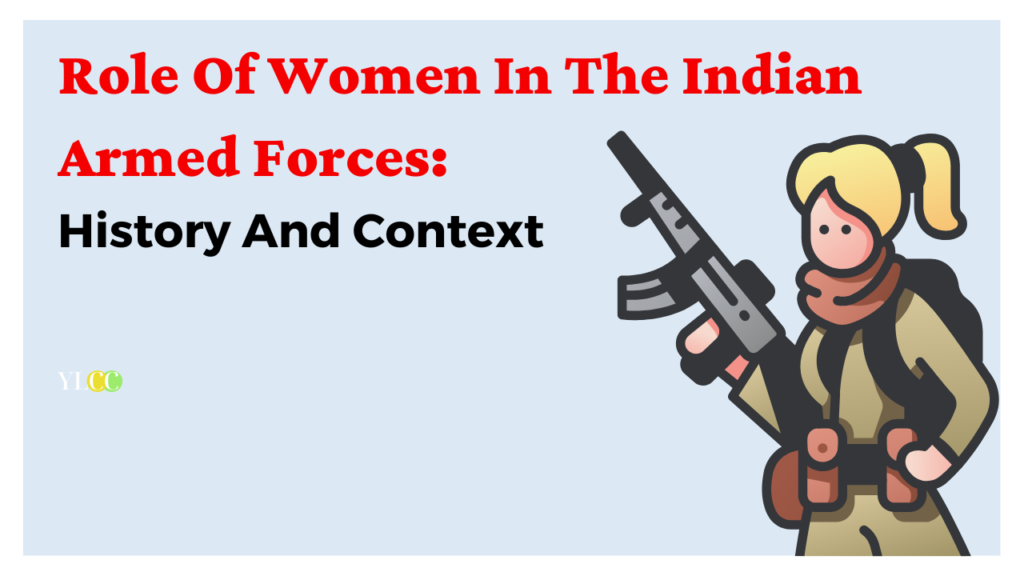
In a landmark judgement for the country’s military, the Supreme Court of India in early 2020 upheld the right of serving Short Service Commission (SSC) women officers to be granted Permanent Commissions (PCs), just like their male colleagues.
Although women in the Indian Armed Forces have been accepted in auxiliary services since the early days of its existence, the issue of including them in combat roles or granting them Permanent Commissions has been ongoing for a long time. However, in recent times, a series of developments has allowed more women to make more substantial inroads into the ranks of Indian military.
In this article, Team YLCC elaborates on the history of the women in the Indian armed forces. Read on!
Women were officially inducted in the Indian military through the formation of the Indian Military Nursing Service in 1888 where they served with distinction during the World War I. After this, the role of women in the Indian Armed Forces was further expanded with the subsequent creation of the Women’s Auxiliary Corps, which allowed them to serve in primarily non-combatant roles like communications, accounting, administration, etc.
Several women member if the corps recorded exemplary service during this time, including one Noor Inayat Khan who served with distinction as a spy during World War II. Although the British Indian Army was limited to women towards what were mainly non-combatant roles, it was not the case with the Azad Hind Fauj founded by Subash Chandra Bose. There was a women’s regiment named the Rani of Jhansi Regiment which saw active combat when it fought along the Imperial Japanese Army in Burma.
A massive development came in 1992 when the Army, Air Force and Navy began inducting women as Short-Service Commission (SSC) officers in 1992. This was the first time in the history of the Indian Armed Forces that women were officially allowed to join the military outside the medical stream.
Why Was Female Participation In The Indian Armed Forces Considered Problematic?
Prior to the 2020 judgement, there were several arguments put forth by staunch opponents of including women for Permanent Commissions in the Indian Armed Forces. Some of them have been mentioned below:
- Indian society is patriarchal in its mindset and hence not ready to see women in active combat roles.
- It was argued that as many of the male servicemen are from rural backgrounds, they might have trouble accepting orders from female officers.
- In times of conflict, a woman personnel getting captured by the enemy may have a detrimental effect on the overall morale of the country.
- There has always been notions that men make better soldiers due to their perceived aggression and physical prowess.
However, the Supreme Court rejected the government’s stand of women officers’ physiological limitations as being based on “sex stereotypes” and “gender discrimination against women”. As a direct consequence of the judgement, women officers have now been granted PC in the Indian Army in all the ten branches where women are inducted for SSC. Women are now eligible to occupy all the command appointments, at par with male officers, which would open avenues for further promotions to higher ranks for them.
Current Position Of Women In The Armed Forces
- In early 2021, the Indian Navy deployed four women officers on warships after a gap of almost 25 years. India’s only aircraft carrier INS Vikramaditya and fleet tanker INS Shakti are the warships that have been assigned their first women crews since the late 1990s.
- In May 2021, the Army inducted the first batch of women into the Corps of Military Police, the first time that women joined the military in the non-officer cadre.
- However, Women are still not allowed in combat arms like Infantry and Armored Corps.
- A major highlight in recent time shas been that Captain Abhilasha Barak who created history be becoming the first woman officer to join the Army Aviation Corps as a Combat Aviator. This comes against the usual convention of considering women only for the responsibility of traffic control and ground duty in the Aviation Department. Captain Barak has been currently assigned to the second flight of the 2072 Army Aviation Squadron that operates the Dhruv Advanced Light Helicopter (ALH).
The Way Forward
To create a sustainable system where more and more women over time can join the Armed Forces, it is important to note the following things:
- Gender Must No Longer Be Considered An Impediment to Military Success– As long as an applicant is qualified for a position, one’s gender is arbitrary. In modern high technology battlefield technical expertise and decision-making skills are increasingly more valuable than simple brute strength.
- Requisite Female Participation Gives The Armed Forces Access To Skilled Staff– Allowing a mixed gender force keeps the military strong. The armed forces are severely troubled by falling retention and recruitment rates. This can be addressed by allowing women in the combat role.
- Training Over Tradition– Training will be required to facilitate the integration of women into combat units. Cultures change over time and the masculine subculture can evolve too. An unreasonable blanket restriction for women limits the ability of commanders in theater to pick the most capable person for the job. Moreover, it is important to acknowledge that it is the right of every woman to pursue a career of her choice and reach the top since equality is a constitutional guarantee.
- At Par With International Developments– When women officially became eligible for combat positions in the American military in 2013, it was widely hailed as another step towards the equality of sexes. In 2018, the UK military lifted a ban on women serving in close combat ground roles, clearing the way for them to serve in elite special forces. In addition to this, Israel, North Korea, France, Germany, Netherlands, Australia and Canada are among the global militaries that employ women meaningfully in front-line combat positions.
YLCC would like to thank the Content Team for their valuable insights in this article.






